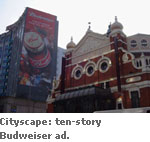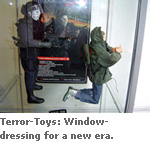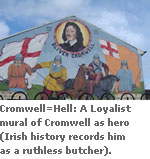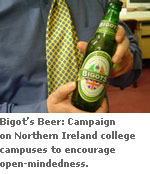I just got back from Belfast, Northern Ireland, where I participated in an international academic conference titled Politics of Design. Numerous trips to the United Kingdom and the Republic of Ireland over the years could not prepare me for the uneasy peace that’s broadcast graphically throughout this city. Protestants and Catholics stake out their geographic and ideological territories by painting murals that demarcate their neighborhoods in no uncertain terms. Loyalists (loyal to the British crown) and Republicans (supporting a unified Ireland on the island) are other terms to respectively describe the sectarian fractions, which are also political in nature. Both aggressively use image, text, symbol and heraldry to advance, or defend, their historical positions by painting large murals on the sides of houses. The shootings and bombings between the sides seem to have abated for now, so that’s reason for cautious optimism.
(Click on images for larger view)
 I had put together a panel called—deep breath here— “Kicking the Edge to Nudge the Center: How North American Designers use Media at the Margins to Affect Political Change”. The panelists were Colette Gaiter of Columbia College in Chicago (“See it Loud! Emory Douglas: The Black Panther Party’s Minister of Culture and Image Architect”), Michael Longford of Montréal’s Concordia University (“ZED: Open Source Television in Canada”), and my University of Minnesota colleague James Boyd-Brent (“The Graphic Personality of Politics”). Another UM colleague, Daniel Jasper, gave a presentation titled “Art War. The Everyday as Battleground for Autonomy, Authenticity and Authority”. In all, our sessions went well with the requisite applause and polite follow-up questions. Daniel distributed his activist posters, as he had done the week before at the Republican National Convention in New York.
I had put together a panel called—deep breath here— “Kicking the Edge to Nudge the Center: How North American Designers use Media at the Margins to Affect Political Change”. The panelists were Colette Gaiter of Columbia College in Chicago (“See it Loud! Emory Douglas: The Black Panther Party’s Minister of Culture and Image Architect”), Michael Longford of Montréal’s Concordia University (“ZED: Open Source Television in Canada”), and my University of Minnesota colleague James Boyd-Brent (“The Graphic Personality of Politics”). Another UM colleague, Daniel Jasper, gave a presentation titled “Art War. The Everyday as Battleground for Autonomy, Authenticity and Authority”. In all, our sessions went well with the requisite applause and polite follow-up questions. Daniel distributed his activist posters, as he had done the week before at the Republican National Convention in New York.
 The binary political relationship in the USA—“red states versus blue states”—is but a simplification device for dramatizing differences at the expense of explaining complexities (1). The “orange” and “green” of the Protestants and Catholics really signifies graphically where one’s margin is: Shankill Road is not to be mistaken for Falls Road. And yet, as with most issues, paradox abounds. Supposedly, a favorite soccer team of the Republicans is Manchester United, a British team. I noticed Guinness signs outside Loyalist pubs. The Linen Hall Library’s “Northern Ireland Political Collection, the definitive archive of the recent troubles” has 250,000 items representing both sides of The Troubles. A toy action figure kit in a shop window featured a black clad terrorist about to shoot a kneeling counter-terrorist, who was wearing an army jacket and jeans; the lack of any signifying colors, words or symbols makes me believe that the roles (and sides) are interchangeable. Only terror wins the game.
The binary political relationship in the USA—“red states versus blue states”—is but a simplification device for dramatizing differences at the expense of explaining complexities (1). The “orange” and “green” of the Protestants and Catholics really signifies graphically where one’s margin is: Shankill Road is not to be mistaken for Falls Road. And yet, as with most issues, paradox abounds. Supposedly, a favorite soccer team of the Republicans is Manchester United, a British team. I noticed Guinness signs outside Loyalist pubs. The Linen Hall Library’s “Northern Ireland Political Collection, the definitive archive of the recent troubles” has 250,000 items representing both sides of The Troubles. A toy action figure kit in a shop window featured a black clad terrorist about to shoot a kneeling counter-terrorist, who was wearing an army jacket and jeans; the lack of any signifying colors, words or symbols makes me believe that the roles (and sides) are interchangeable. Only terror wins the game.
 On the last day of the conference, Daniel, Michael, Martin Schmidl (a professor from Munich) and I rented a cab to tour the murals, so we could take some photos. Supposedly, many cab drivers will do one neighborhood or another, but not both. Our fellow did do both sides, with historical accuracy, insightful anecdotes and a lack of bias, and for this we were grateful. His son was the victim of sectarian violence, a survivor now with a rebuilt jaw and full dentures.
On the last day of the conference, Daniel, Michael, Martin Schmidl (a professor from Munich) and I rented a cab to tour the murals, so we could take some photos. Supposedly, many cab drivers will do one neighborhood or another, but not both. Our fellow did do both sides, with historical accuracy, insightful anecdotes and a lack of bias, and for this we were grateful. His son was the victim of sectarian violence, a survivor now with a rebuilt jaw and full dentures.
The Loyalist murals featured the red and white of the English flag, and with blue the Union Jack, the recurring “red hand” symbol, paramilitary troops wielding AK-47’s, and block or Roman capital lettering. They often invoked historical events, like Oliver Cromwell’s crusade, the Queen’s Golden Jubilee or the 1690 Battle of the Boyne.
Republican murals often featured the uncial typefaces that reference Ninth Century Celtic typography, and some were in the Gaelic language, which is being revived in parts of Ireland. They often depicted the martyrs of the Republican resistance: hunger strike victims (even painted with people like Martin Luther King and Mahatma Gandhi), or victims of “Bloody Sunday”. Some Republican areas flew the Palestinian flag, to show camaraderie with their struggle, and a few murals aligned with other efforts for independence, like the Catalonia region of Spain.
Supposedly the muralists do not consider themselves artists, even though most murals were competently painted, with good attention to technique, color, and visual narrative. Both sides are willing to paint over their murals when the time comes to tell another story or depict a different image. Although the rhetorical tone of the murals is provocative, even incendiary, perhaps they serve as a kind of dialog.
 My city-center hotel, the Europa, having been bombed forty-some times by the IRA (but not while Bill Clinton was there), featured a ten-story Budweiser ad on one wall. The bottle top extends invitingly, with the familiar printed word: Bud. “Let’s be friends, buddy. We can put our religious and political differences aside and enjoy the benefits of global consumerism!” However, the actual “buddy” campaign underway at Northern Ireland’s institutions of higher learning, which encourages students to set aside their prejudices, is a fictitious beer brand called Bigots.
My city-center hotel, the Europa, having been bombed forty-some times by the IRA (but not while Bill Clinton was there), featured a ten-story Budweiser ad on one wall. The bottle top extends invitingly, with the familiar printed word: Bud. “Let’s be friends, buddy. We can put our religious and political differences aside and enjoy the benefits of global consumerism!” However, the actual “buddy” campaign underway at Northern Ireland’s institutions of higher learning, which encourages students to set aside their prejudices, is a fictitious beer brand called Bigots.
Notes
(1) see Harper’s Magazine from April 2004 for a great article on this topic:
“Lie Down for America: How the Republican Party sows ruin on the Great Plains”
by Baffler editor Thomas Frank.
![]()
Steven McCarthy, (MFA 1985, Stanford University) is an Associate Professor of Graphic Design at the University of Minnesota. Besides Belfast, Steven has lectured at academic conferences in New York, Boston, Montréal, London and Istanbul. Steven’s recent creative production includes having a poster juried into “I Profess”, and having an 8-page spread in Kenneth FitzGerald’s “News of the Whirled 4”. He was pleasantly surprised recently to find himself cited in Rick Poynor’s No More Rules: Graphic Design and Postmodernism on the topic of design authorship. To learn more about Steven’s work, visit his web site: www.episodic-design.com.






What a great article. I'm fascinated with the concept of "fighting" with graphics. As undesirable as it sounds, if only wars could be fought as benignly as stating your opinion/case/history/protest in opposing graphic displays. These are, of course, also territorial pissing: graphics as demarcation lines ... something that would be useful in many urban areas: overt visual displays of the territory you are in.
It's also interesting that their cases are stated in these historical/allegorical/mythological contexts, instead of just writing "Kill all brits" or some other predictably explosive statement, the murals seem to go deeper. More of a "This is why" statement: historical support for their cause.
Thanks for this, it was all news to me.
On Sep.24.2004 at 09:52 AM